This beginners guide to baby-led weaning is a comprehensive guide that will help feeding newbies learn everything there is to know about this starting solids strategy, why it is registered dietitian-approved, how to implement it, and some nutritious recipes to test out with their babies.
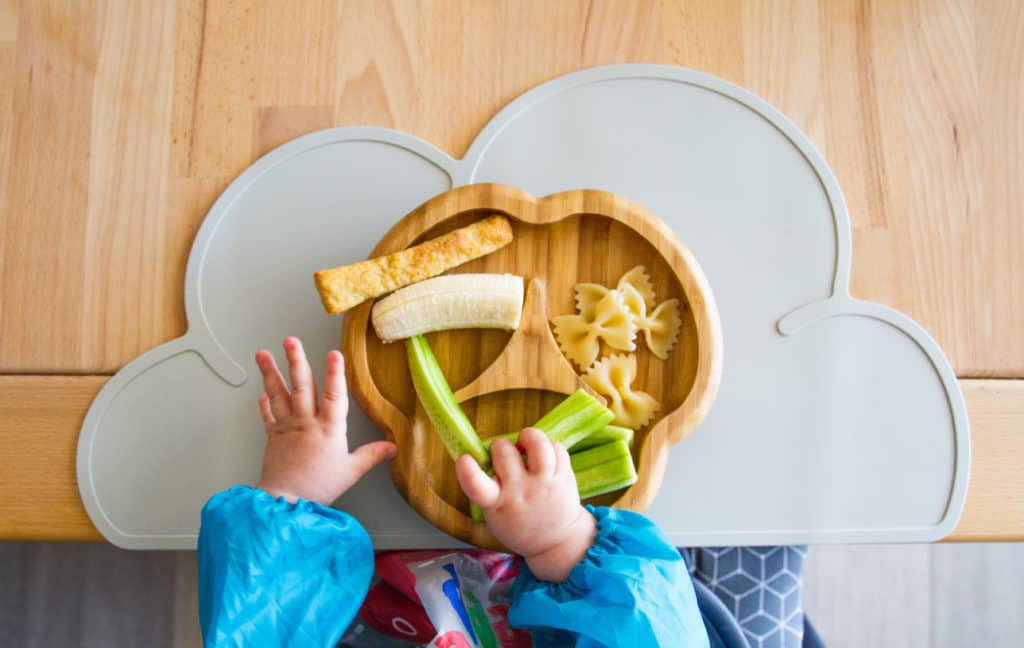
Baby-led weaning (BLW), which is one approach to starting solids, has become a popular strategy for parents of babies over the last decade, for good reason. Essentially, it’s a feeding strategy that involves no spoon-feeding or purees; only soft, safe finger foods (that baby self-feeds), right from 6 months of age.
There are many potential benefits to baby-led weaning, including improved dexterity, early oral-motor skill development, better self-regulation, ease for parents (no pureeing needed!), decreased chances of picky eating and more. At the same time, it can also be a little bit scary and nerve wracking—especially for new parents—largely because of the perceived risk of choking (read more about choking and baby-led weaning.)
Need personalized nutrition support?
Book an appointment with one of our pediatric dietitians today!
It’s important to know that there is no single “right way” to introduce solids to your baby, whether you want to start with traditional spoon-feeding or try baby-led weaning. I support either way (or a combo) wholeheartedly. What’s most important is that baby is introduced to a wide variety of tastes and textures within the first couple of months of starting solid foods, and that all feeding be baby-led (aka responsive feeding). Babies need to learn to trust their bodies when it comes to eating and to self-regulate their appetite. The best way to help them do this is to let them lead and follow their cues.
Don’t worry—I’ll walk you through everything you need to know as a pediatric dietitian.
Here’s what you’ll find in this post:
- What is baby-led weaning (BLW)?
- What is responsive feeding, and how does it relate to baby-led weaning?
- Should I spoon-feed my baby or do baby-led weaning?
- Will my baby get enough iron with baby-led weaning?
- Choking vs. gagging and baby-led weaning
- How can I tell if my baby is ready for baby-led weaning?
- What you need to get started with baby-led weaning
- Can you serve baby the same foods as the rest of the family when doing baby-led weaning?
- What are the best first foods for baby-led weaning?
- What to look for when buying packaged, store-bought food products for baby
- How big should food pieces be for baby-led weaning (month-by-month)
- Meal planning for baby-led weaning
- Baby-led weaning recipes to try with your baby
What is baby-led weaning (BLW)?
Baby-led weaning means that you skip purees and spoon-feeding altogether. Instead, you offer your baby soft finger foods right from the get-go. The potential benefits of this method are:
- Baby learns to feed independently from an earlier age and develops fine motor skills
- Baby is 100% in charge of what and how much they eat at any given meal or snack
- Can potentially reduce picky eating later on
- Cuts down on time spent making homemade pureed baby food
- Cuts down on grocery costs because there is no need to buy store-bought baby food
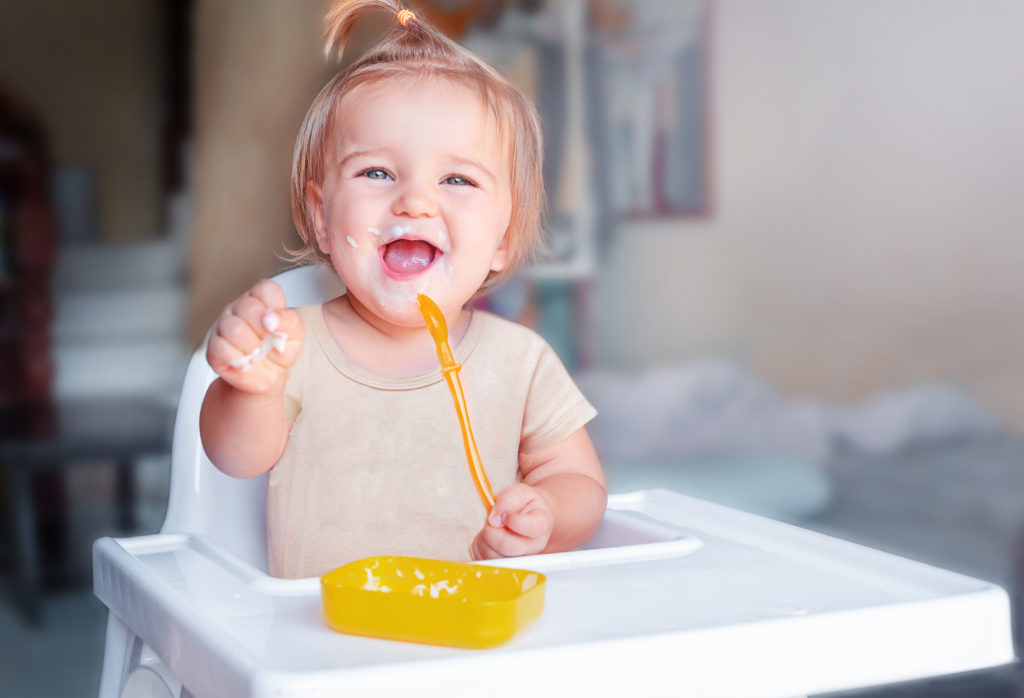
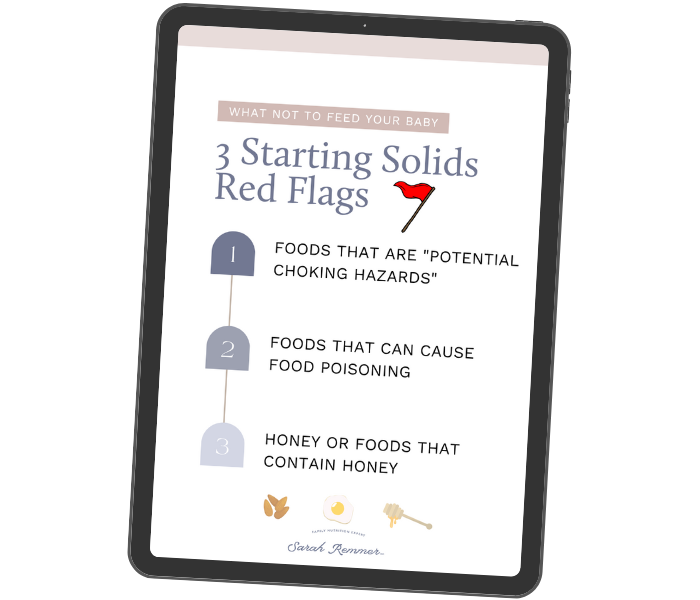
Starting solids? Don’t panic.
Starting solids is an exciting milestone in your baby’s life, but it can also be confusing, especially when you’re overloaded with conflicting information on how and when to do it. Download your free guide to starting solids and clear the confusion!
What is responsive feeding, and how does it relate to BLW?
Responsive feeding is a way of describing the two-way feeding relationship between parent and child, when parents pay close attention to their child’s hunger and fullness cues (verbal or nonverbal), and then responds accordingly. For young babies, who are feeding on demand, this means responding to cues that tell you they want to start, slow down or stop feeding. For older babies and toddlers, who have a more established routine of solid food meals and snacks, this means responding to signs of hunger or fullness—offering more when they cue for more, and slowing down or stopping when they indicate fullness. Paying attention to hunger cues will help to avoid overfeeding and underfeeding, and may help to positively influence a child’s ability to self-regulate their food intake long-term. Responding to your child quickly, communicates to them that you love them, support them and trust them, and this helps build their emotional health and a foundation of trust between you for years to come.
To be able to play your part in responsive feeding, you need to be present and engaged in feeding times—not on the phone and doing laundry, too! Trust me, I’m all too familiar with multi-tasking as a mom, but it’s important that during feeding time you’re dedicated to being present and focusing on your child.
Should I spoon-feed my baby or do “baby-led weaning”?
You’ve probably noticed that the buzz phrase these days is definitely “baby-led weaning,” whereas spoon-feeding and purees have sort of become old-school methods. But you can safely feed your baby using either method (or even a combo, which is what I recommend)! There is no right or wrong. As long as you’re feeding “responsively” (see above), and offering a variety of tastes and textures in the first couple of months, spoon feeding and self-feeding are both great. It really depends on what works for you—and more importantly, what works for your baby. Some love to be fed, and others prefer to self-feed. And this may depend on the day, the type of food, or your baby’s mood!

Will my baby get enough iron with baby-led weaning?
Some nutrition experts (and parents) worry about adequate iron intake if you choose baby-led weaning. Iron-rich foods such as red meat, fish, legumes, and eggs are important for babies over 6 months of age, as their iron stores have been depleted. Babies who are fed using baby-led weaning may fall short of iron, which puts them at risk for iron deficiency anemia. It’s a bit more challenging to ensure baby receives enough of this nutrient when they’re exclusively self-feeding. Quite simply, they may not pick up and eat those strips of meat or pieces of scrambled egg! And you certainly don’t want to force it.
This is one of the reasons why I usually recommend a combination of responsive spoon-feeding and baby-led weaning- there are just more opportunities to meet iron those requirements!
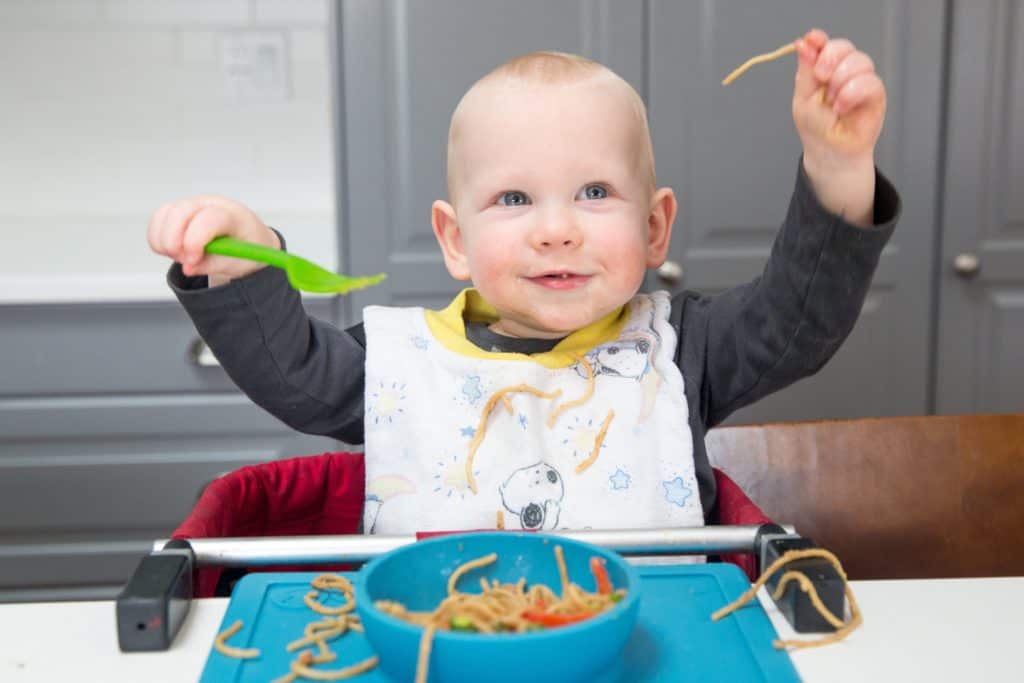
Choking vs. gagging and baby-led weaning
Choking and baby-led weaning
I often hear from parents who are contemplating the baby-led weaning approach “will my baby choke on solid foods?”. Now, choking is serious business, and I would never recommend a practice that was dangerous in any way. Often, though, choking gets confused with gagging—which is completely different. Gagging is extremely common when babies are starting solids. The gag reflex keeps larger food pieces out of the wind pipe and near the front of the mouth, only allowing very well-chewed foods to the back to be swallowed. It’s a safety mechanism to prevent choking!
A study compared a group of babies who were fed by baby-led weaning (whose parents were trained in this method) to a control group using the standard puree method. While the baby-led weaners did gag more at 6 months than spoon-fed babies, they gagged less by 8 months. By this time, the baby-led weaners were used to eating solids, and the pureed feeders were just starting! And there was no difference in the number of actual choking episodes reported between the 2 groups.
No matter what, this is priority number 1: make sure you take a baby first aid and CPR training course. Find one through your local hospital, public health center, or community center. It’s so important to be confident and knowledgeable about how to react in an emergency like choking.
Note that most foods that are choking hazards are round or oval, hard, smooth, and small. Use your judgment. Read more for a list of common choking hazards and safer ways to serve them.
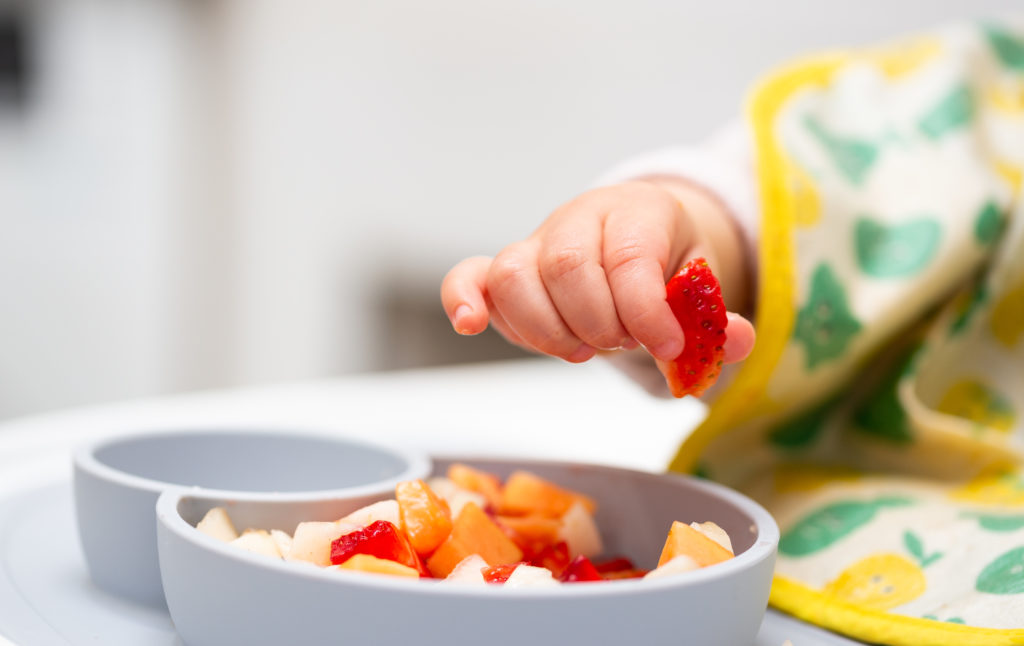
Gagging and baby-led weaning
Your baby will likely gag. A lot. Babies have a great natural gag-reflex that helps them move food that has travelled too far to the back of their mouths, back to the front again so that they don’t choke.
They may make a funny face and make a gagging sound, and their face may turn red, but if you wait for a few seconds, you’ll see that your baby is an expert at this and will not choke.

How can I tell if my baby is ready for baby-led weaning?
Most nutrition experts, including me, recommend that you introduce solid foods around the age of 6 months. This is particularly true if you’re choosing to do baby-led weaning. Baby’s aren’t developmentally ready to manoeuvre solid pieces of food in their mouths before about 6 months. But more important than the exact age your baby starts solid foods, is making sure your baby is ready for solid food. It may be a week or two earlier or later than 6 months, and that’s totally okay. All babies develop at different rates. Watch your baby’s cues and introduce solids when they are ready. Signs of readiness include:
- Baby can sit, supported. Baby should be able to sit in a high chair, feeding seat, or infant seat, supported, with good head and neck control.
- Baby opens their mouth when food comes their way. Baby may be ready if they watch you eat, reach for your food, and seem eager to eat.
- Baby can maneuver food from a spoon to the back of their throat. If you offer a spoonful of food to baby and they push it out with their tongue and it dribbles onto their chin (the tongue thrust reflex), they may not be ready yet. You could try diluting it the first few times, then gradually thicken the texture, or you may also want to wait a week or two and try again.
- Baby is big enough. If your baby has at least doubled their birthweight and weighs at least 13 pounds, they may be ready to start solids.
What you need to get started with baby-led weaning
It’s no secret that baby-led weaning is definitely messier than spoon feeding, so it’s important to go in knowing that you’ll spend some time cleaning up. I always reminded myself that I would still be saving time by not pureeing for hours on end!
Here are a few things that I recommend if you’re starting with baby-led weaning:
- Book: “Food to Grow On, The ultimate guide to childhood nutrition, from pregnancy to packed lunches” by Sarah Remmer, RD and Cara Rosenbloom, RD
- Highchairs: my favourites are this one, this one and this one)
- Spoons (I like these spoons, this fork and spoon combo and these sensory spoons)
- Bibs (I like this tray bib and these waterproof bibs)
- Baby Feeding Tarp
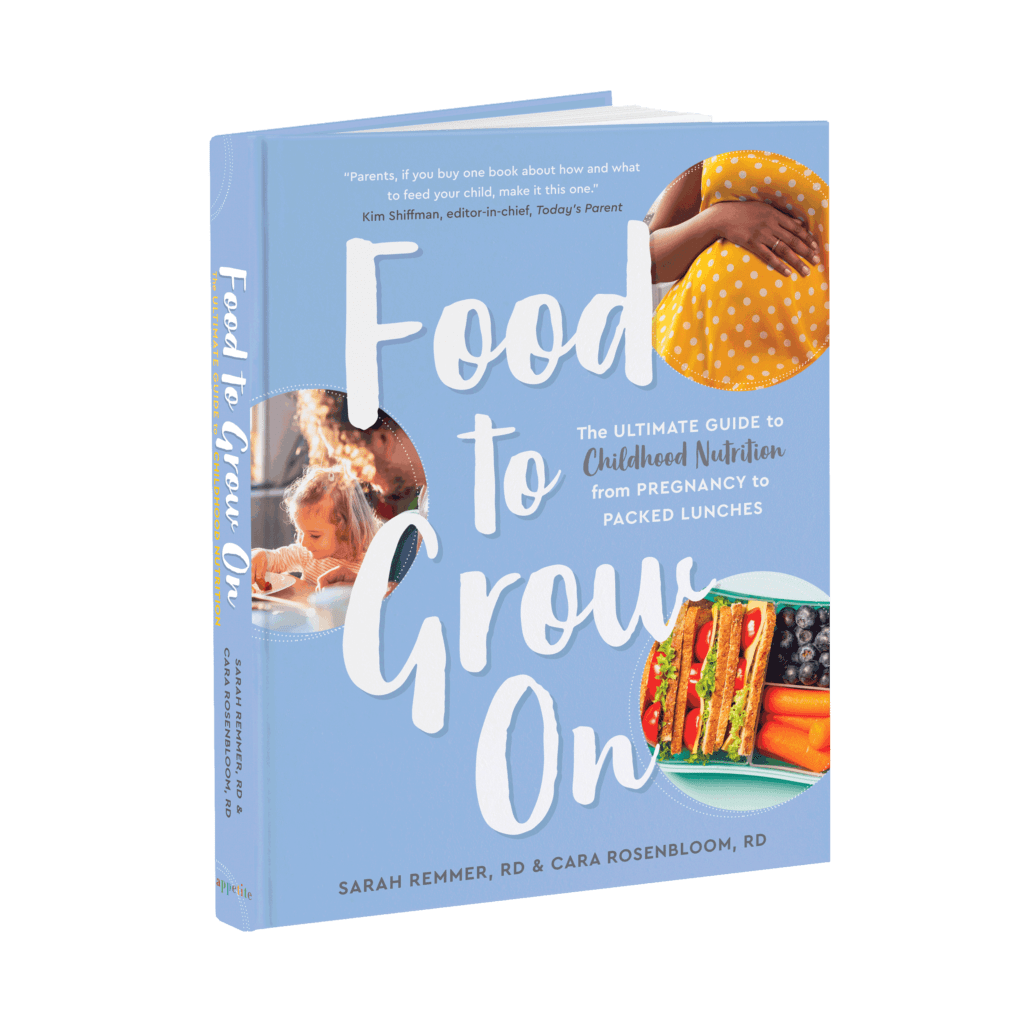
Food to Grow On
Food to Grow On is the definitive guide to childhood nutrition, packed with practical advice to support you through pregnancy, and up until your little one starts school.
Laid out in an easy-to-navigate question and answer style, this book provides practical advice and support from Sarah Remmer and Cara Rosenbloom, two trusted registered dietitians (and moms). Food to Grow On is packed with hard-earned parenting wisdom and the very latest research in pediatric nutrition, so you will feel supported, understood, and ready to help your child thrive.
Can you serve baby the same foods as the rest of the family when doing baby-led weaning?
One of the perks of baby-led weaning is that your baby can eat the same meal as the rest of the family. Sort of.
The food that I typically make is quite flavourful, sometimes spicy and usually contains seasonings such as salt and pepper—things that six-month-old babies don’t need. A baby’s kidneys are not mature enough to handle much added salt (sodium) or sugar, so it’s important to keep this is mind when you’re preparing and cooking food. But adding natural flavour and seasoning with things like garlic, ginger, mild curry, cumin, herbs etc. is totally fine (and recommended!).
There’s no need to purchase a special baby-led weaning cookbook if you don’t want to. Instead, you can do what I did and just tone down the spice and the seasoning a lot. Here are some examples of how I “baby-proofed” our family meals:
- Hold the salt and pepper when preparing a meal and add it in after you’ve served your baby
- Use fresh chicken and homemade pizza sauce on our pizza’s (instead of ham or store-bought pizza sauce)
- Scoop out stir-fried meat and veggies prior to adding stir-fry sauce
- For homemade hamburgers, leave the seasonings out of some of the meat mixture.

What are the best first foods for baby-led weaning?
I guarantee that if you’ve looked into this question, you’ve heard some of the following answers (depending on who you ask!):
Start with rice cereal!
Start with pureed vegetables!
Start with avocado!
Start with meat!
Start with banana!
– Random people
So which is the correct answer? They are all correct, and the first food you offer your baby is your choice. There’s no one perfect answer for everyone. But that’s more fun for you, because you get to plan your baby’s menu!
Historically, the guidelines for starting solids were a little more structured. It was recommended that parents introduce one food at a time, waiting a few days in between to be able to recognize a potential food allergy. New guidelines aren’t as strict—it’s okay to introduce more than one food at a time, and there’s no need to follow a certain order of foods. Of course, this is all up to you as the parent and based on your comfort level.
If you or your partner have allergies, you may want to introduce common allergens (egg, peanut, nut, soy, fish, wheat, milk, sesame) one at a time to watch for reactions. This may also be the suggestion from your doctor, especially if baby also has shown signs of eczema, which goes hand-in-hand with some food allergies.
At 6 months, it’s safe to introduce all foods—vegetables, fruits, grains, meat, poultry, fish, eggs, natural nut and seed butters, and pasteurized dairy products, with the exception of bottles filled with fluid cow’s milk, and choking hazards (see above). In any order you’d like. Most babies are ready for a variety of food textures too. For more on appropriate textures month by month, keep reading.
Remember to make iron-rich foods the priority when starting solids
This is because baby’s iron stores are becoming depleted at 6 months and they require this nutrient from food for proper growth and development. Iron-rich foods include meats, poultry, fish, beans, lentils, and iron-fortified infant cereals. They don’t need to be the first foods your baby ever tastes, but you should offer iron-rich foods at least twice a day from the get-go.
Iron-rich foods for baby-led weaning and spoon-feeding
- Soft and tender pieces of meat or poultry
- Finely minced, ground, or mashed cooked meat
- Deboned fish
- Well-cooked whole eggs
- Beans and lentils
- Iron-fortified whole grain infant cereals
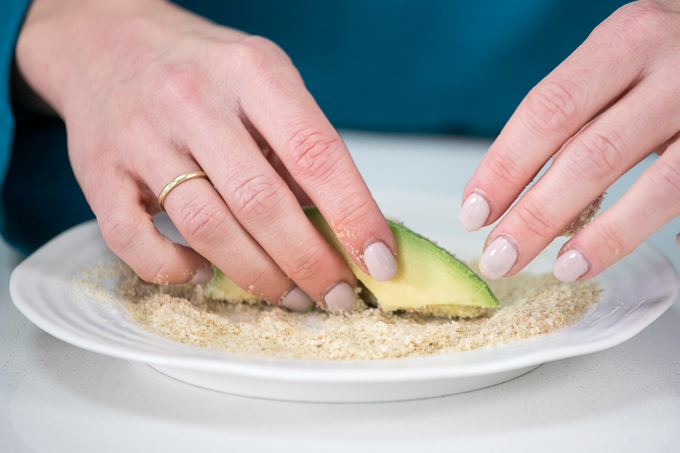
What if I’m raising my baby as vegetarian?
Solid foods can be introduced in the same way for vegetarian or vegan babies who eat mostly plant-based foods. Simply replace iron-rich meat with soft or mashed tofu, beans, lentils, and chickpeas. You can also offer eggs, full-fat yogurt, and cheese (if vegetarian).
Here’s some information on introducing allergenic foods to baby and on when and how to transition baby to cow’s milk. And if you’re looking for an amazing and safe way to introduce allergenic foods into babe’s diet, you must give Ready, Set, Food! a try! It’s the only product that dissolves easily in breastmilk and formula, so you don’t have to wait until your baby is eating solids.
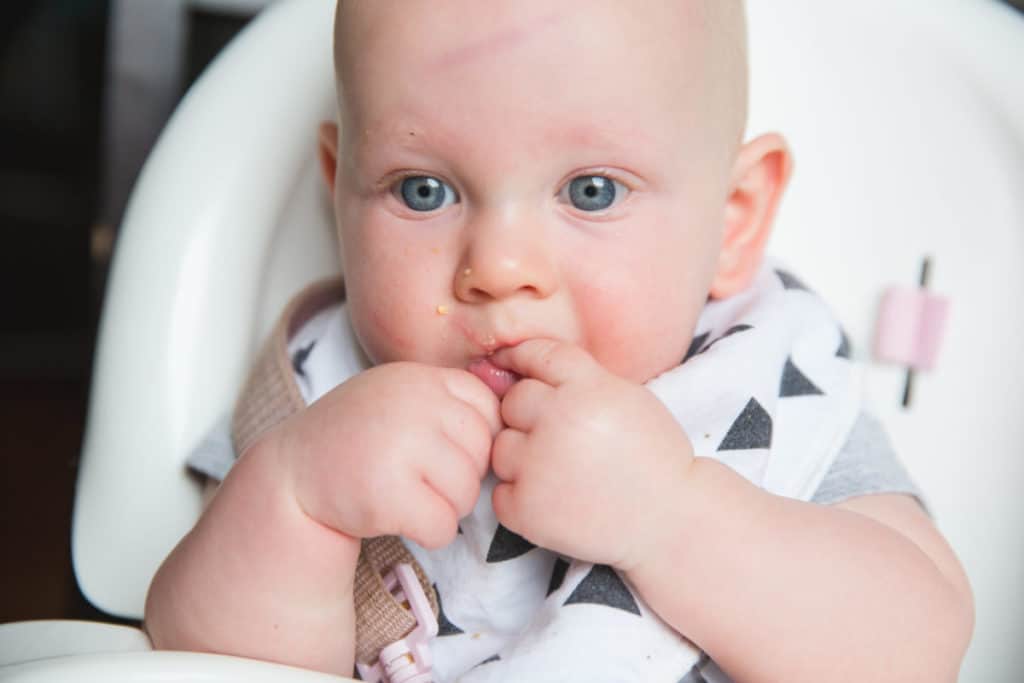
Packaged, store-bought foods for baby-led weaning:
As a dietitian, I was quite particular about what types of food products I fed my babies, and did my best to stick to whole, fresh (or whole frozen and thawed foods) foods first and foremost. These are the most nutrient-dense. But as a busy mom, I knew (and know) that packaged store-bought baby foods come in handy when you’re on the go, in a rush, or just need some variety. When buying food products at the store, make sure that the ingredients list is short, recognizable and contains whole foods like fruits, vegetables, legumes and whole grains. Watch out for any added sugar too or salt–babies don’t need these. Compare two or three similar products and choose the one that has the shortest and most recognizable ingredients list. There are many options for store-bought baby finger foods now, which is great. Again, look at the ingredients list and choose one that offers real, nutritious ingredients like fruit, veggies, whole grains and legumes.
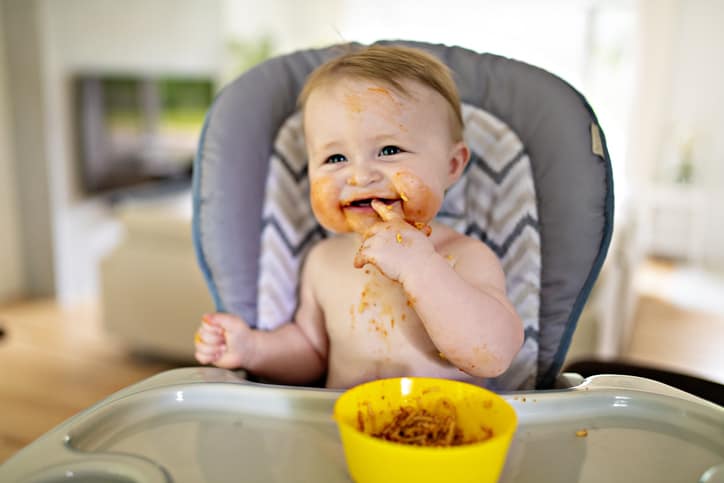
How big should food pieces be for baby-led weaning?
You may be tempted to cut your baby’s food into teeny tiny pieces so that they don’t choke. Unfortunately, babies don’t have the fine motor skills (particularly, the “pincer grasp”) to pick up tiny pieces of food and bring them to their mouths until they are around eight or nine months old (or older). This is why it’s so important that you make baby’s food pieces large enough that they can grab onto them (but soft enough that they’re safe).
A homemade potato wedge or half of a skinless, boneless chicken thigh cut length-wise, or a slice of pear (peeled) are examples of appropriate sized pieces of food. A piece of whole grain toast with some butter on it cut into thick strips would be appropriate too.
Your baby should be able to pick up their food, bring it to their mouth, and gnaw on it. It’s normal for baby to “miss” their mouth or drop their food, but as long as they can bring it to their mouths, it is likely appropriate in size.
It is still very important to avoid foods that pose a risk of choking for the first year of life, such as hard fruits and vegetables (ie. raw carrots), stringy foods (ie. celery), nuts and seeds, whole grapes, a gob of peanut butter (I thinly spread on toast strips), wieners and popcorn (see full list above!).
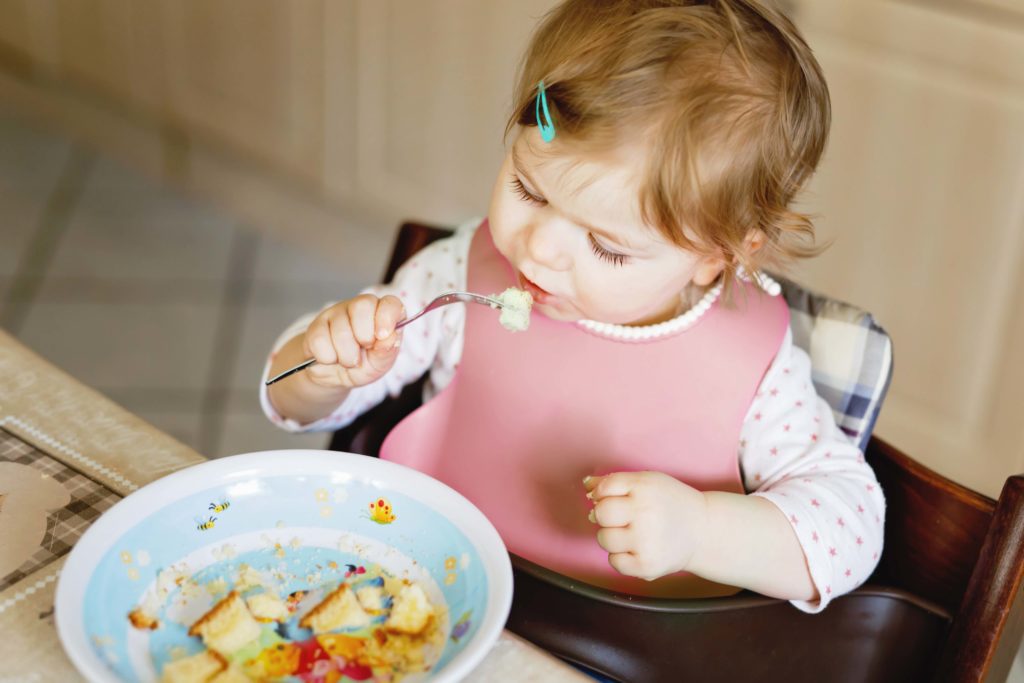
Appropriate shapes, textures and sizes at every age
Whether or not you choose to be a strict baby-led-weaner or do a combo of BLW and spoon feeding (which is what I did), it’s important to know what size, texture and shape of food is appropriate at each stage. Through the ages of 6 to 12 months, you can expand the textures and sizes of foods that are suitable to serve. As babies grow, they slowly develop more mature chewing and swallowing skills, as well as better finger dexterity and fine motor skills. This helps them handle firmer, smaller pieces of food. As you watch your baby eat, you will notice changes in the size of pieces that they can pick up.
Every baby develops at a slightly different rate, and that’s okay! While one baby might be ready to pick up small peas and blueberries by 9 months, another might not be ready until 11 months. These suggestions are just a loose guideline of which textures and sizes of food to offer at each age and stage. Of course, pay close attention to your own baby to know what’s right for them.
As your baby becomes a more confident feeder, move to the next stage. By the time they turn one, your baby will be self-feeding like a pro—you got this!
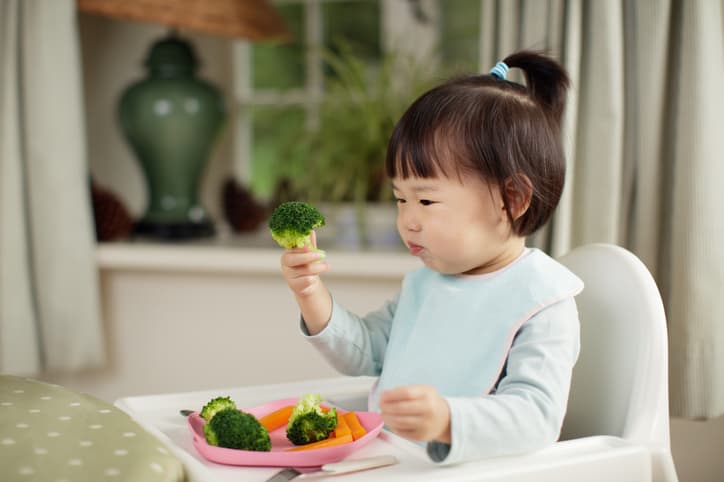
6 TO 7 MONTHS
Protein/iron-rich:
- Meat and poultry: Minced; pureed; slow-cooked and shredded; or meatballs or patties.
- Low-mercury fish: Deboned, then soft-cooked or pureed fish.
- Eggs: Hard-boiled and mashed; omelets cut into strips; or scrambled.
- Legumes: Cooked and mashed or pureed beans, lentils and chickpeas. Silken or mashed firm tofu.
- Cheese: Thinly sliced or grated
- Nut butter: thinly spread on toast strips; or stirred into infant cereal
Fruits and vegetables:
- Soft fruits: Peeled and cut into large strips – try avocado or ripe pear.
- Bananas: Leave half the peel on to help baby’s grip.
- Hard fruits and vegetables: peeled and steamed until soft, then mashed or pureed (4), or cut in large strips as finger food. Try green beans, carrots, zucchini or apples.
Grains:
- Whole grains: Cooked and spoon-fed quinoa or oats.
- Whole grain bread: Toasted and cut into strips.
- Iron-fortified infant cereals: Mashed with breastmilk or formula .
8 TO 9 MONTHS
Continue to serve any of the foods from 6-7 months, and progress to these textures when your baby seems ready:
Protein/iron-rich:
- Meat, poultry and fish: Medium-sized, soft-cooked pieces.
- Legumes: Lentil or bean patties (see my homemade lentil patties here).
Fruits and vegetables:
- Soft fruits: Medium pieces of soft or steamed options such as raspberries , kiwi, or peach
- Raw vegetables and fruits: peeled and grated apple or carrot
Grains:
- Large-flake or steel-cut oats: Thicker than baby’s first iron-fortified baby cereals
- Pasta: Bite-size cooked shapes, such as penne or macaroni
- Firmer grains: Farro or barley
10 TO 12 MONTHS
Continue to serve the foods above, and progress to these textures when your baby seems ready. Now that baby has better dexterity, pieces can be smaller.
Protein/iron-rich:
- Meat, poultry and fish: Smaller pieces of pulled roast chicken
- Legumes: Cooked whole beans or lentils and cubed firm tofu.
- Dairy: Cheese cubes.
Fruits and vegetables:
- Hard vegetables: smaller pieces of raw peeled cucumber or steamed carrot coins
- Dried fruit: Cut apricots or whole raisins.
- Fruits: Raw small pieces, such as sliced grapes and small whole blueberries
Grains:
- Pasta: Offer as part of mixed meals, such as ravioli, spaghetti and meatballs, or soup.
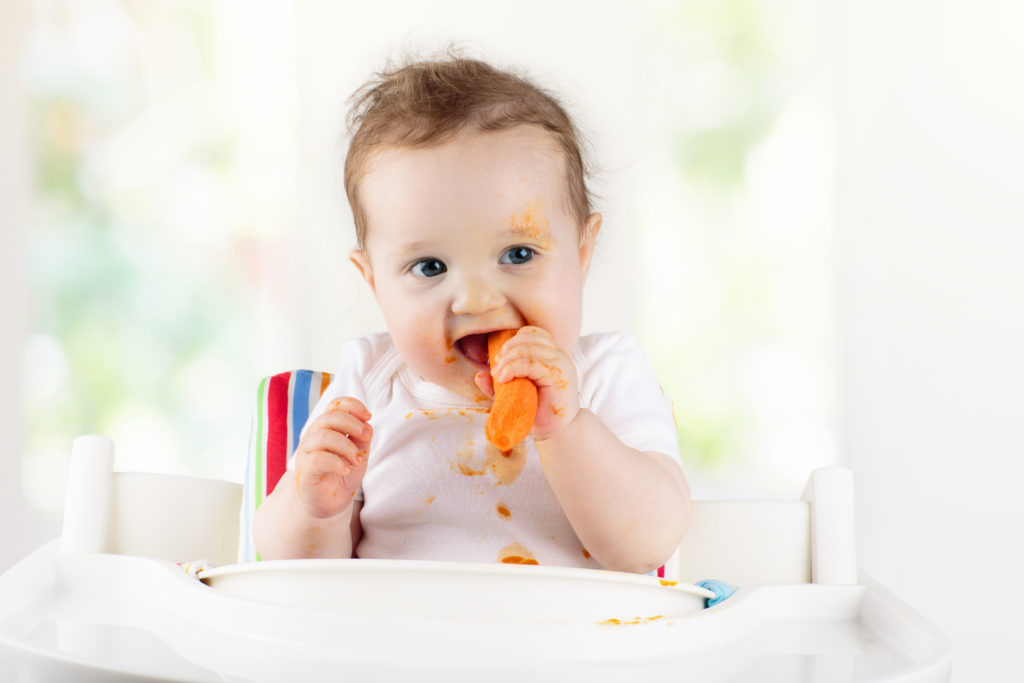
Meal planning for baby-led weaning
Now that baby is starting to partake in meals, your schedule is going to become more consistent. Remember those days of nursing around the clock and napping whenever? Those are a thing of the past. But that’s a good thing! This consistency will help put some freedom into your routine because you’ll be able to predict when baby is going to be hungry. Consistency and routine is also good for babe. It helps them to learn how to self-regulate their appetite. Kind of like how you eat breakfast, lunch, dinner, and snacks. So will they—eventually!
Timing of meals and snacks with baby-led weaning
The timing of breast- or bottle-feeds in relation to solid foods is up to you. Some parents choose to have a set breast- and bottle-feed schedule; for example, a feed in the morning, another at night, and another just before or after mealtimes. Others prefer to fly by the seat of their pants!
Either way, solid feeds should start at 1 meal per day and gradually increase to 3 meals per day by 9 months of age. Start by serving breakfast. Then after a few weeks, try adding lunch too, and then eventually add dinner. Make sure it’s a slow transition. You don’t go from exclusively breast- or bottle-feeding to 3 square meals a day right when your baby turns 6 months old. It’s a gradual climb to get there.
Once baby reaches about 9 or 10 months of age, they will be enjoying breakfast, lunch, and dinner, just like you! This is when you can start adding “snacks” in between meals. The introduction to real-food snacks can be gradual too. Eventually, you will be feeding your little one 4 to 6 times a day (kind of like you!).
Breastfeeding and baby-led weaning
When solid food feeds start, breastfeeding should continues on-cue (if you breastfeed your baby that is). The WHO (World Health Organization) says that “whether breastfeeds or complementary foods are given first at any meal has not been shown to matter. A mother can decide according to her convenience and the child’s [cues]” which will change with the baby’s age and feeding regime.
Time your baby’s meals so they eat with you (and your family) at the table. When you eat breakfast, they eat breakfast. This will eliminate the need to transition to family meals later on (and save you time!).
Following a strict meal plan for your baby just isn’t necessary, and it can actually set unrealistic expectations about how much your baby should eat at any given time (because in reality, this could be all over the place!). For those of you who like a bit of a guide, below are some sample meal plans for babies 6 to 9 months and 9 to 12 months. Serving sizes are intentionally not given as all babies eat different amounts, so let your baby’s appetite be the guide.
Sample meal plan for baby-led weaning 6-9 months and 10-12 months
Feeding suggestions: 6 to 9 months
| Timing | Foods to offer (try a variety) |
| Early morning | Breastmilk or formula Vitamin D drops (for breastfed babies) |
| Breakfast | Breastmilk or formula Small bowl of whole grain, iron-fortified infant cereal mixed with breastmilk, formula, or water Add some banana and full-fat plain yogurt |
| Mid-morning snack | Breastmilk or formula |
| Lunch | Breastmilk or formula Small salmon pieces (poached or baked) with quinoa and soft or grated vegetables like squash or carrots |
| Mid-afternoon snack | Breastmilk or formula |
| Dinner | Breastmilk or infant formula Beans or lentils, a few cheese cubes, and some cooked vegetables like broccoli or cauliflower; you can add fruit too |
| Before bed | Breastmilk or formula |
Feeding suggestions: 9 to 12 months
| Timing | Foods to offer (try a variety) |
| Early morning | Breastmilk or formula Vitamin D drops (for breastfed babies) |
| Breakfast | Oatmeal made with whole milk or breastmilk, full-fat yogurt, and soft fruit (seedless watermelon, banana, etc.) Breastmilk or formula |
| Mid-morning snack | Strips of whole grain toast with thinly spread natural peanut butter; grated apple Breastmilk or formula |
| Lunch | Sliced or chopped soft-cooked meat, cooked whole wheat pasta, cubed avocado, and cucumber strips Breastmilk or formula |
| Mid-afternoon snack | Unsalted whole grain crackers, cheese or hummus, and soft-cooked carrots Breastmilk or formula |
| Dinner | Chicken or tofu cubes, peas, and soft fruit like ripe mango or quartered grapes Breastmilk or formula (or whole cow’s milk at 12 months) |
| Before bed | Banana Breastmilk, formula (or whole cow’s milk at 12 months) |
Recipes for baby-led weaning
*please note: for any recipes with added salt or sugar, leave it out or minimize for baby
Babies need to be exposed to a variety of foods, tastes, and textures within the first few months of starting solids–including soft, safe finger foods such as these finger food recipes.
Remember to go with the flow
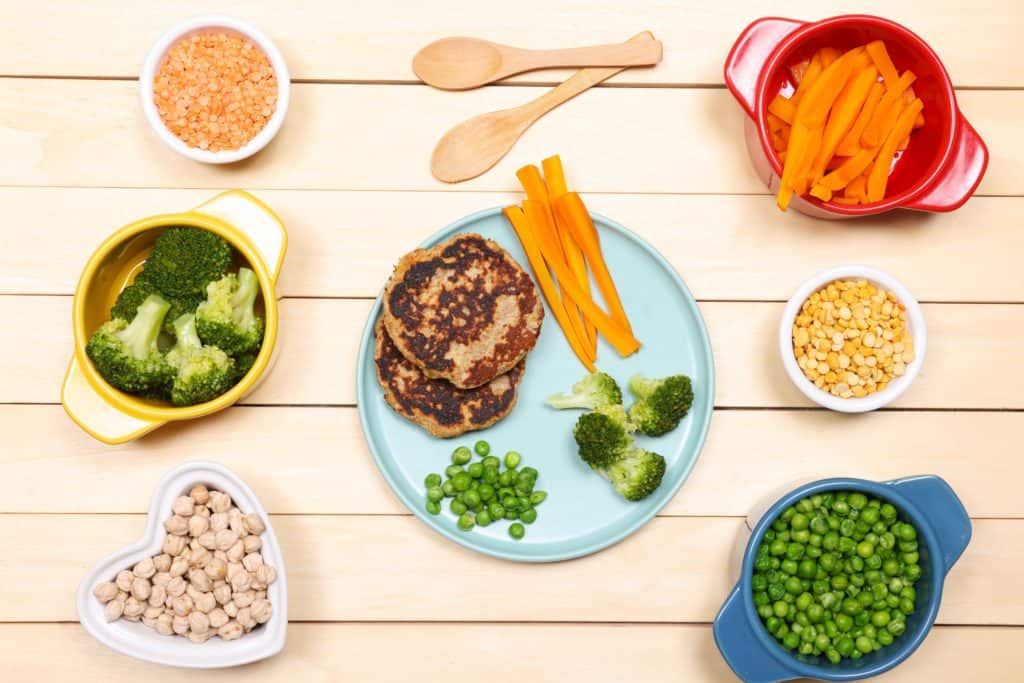
Your baby may absolutely LOVE self-feeding right from day one, and she may go through periods where she’d rather be spoon-fed. My daughter for the most part has thrived with baby-led weaning, but she went through a period when she was teething, where she wanted to be fed pureed food with a spoon (presumably because it was softer and didn’t hurt).
When and if you do feed purees, either make them yourself or choose nutritious, whole-food-focused options from the grocery store. Know that it’s completely normal for your baby to reject a food, spit it out or throw it. It may take up to 20 exposures for a baby to accept a food so keep re-introducing the food pressure-free.
Include baby in family meals (this is the beauty of baby-led weaning) and give him/her the food that the rest of the family is having (assuming it isn’t a choking hazard). Know that most of the food may end up on the highchair, on the walls or on the floor, and this is ok.
Your baby is getting much of their nutrition from breastmilk and/or formula until one year of age. Have fun with it!
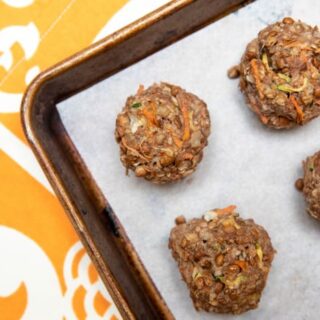
Baby-Led Weaning Recipes: Turkey Lentil Meatballs & More
This delicious baby-friendly meatball recipe is nutritious, filling and perfect for little bodies that are growing and developing!
Ingredients
- 1lb of ground turkey (you can use any ground meat)
- 1 can lentils, drained and rinsed
- 1 cup rolled oats (you can substitute ½ of this for iron-fortified infant cereal if you have some that you have to use up)
- 2-3 eggs
- 1 cup grated or chopped veggies (I use a combo of grated carrot, chopped spinach, and grated zucchini)
- 1/2 cup parmesan cheese, grated
- 1 tsp garlic powder
- other dried herbs (optional)
Instructions
- Preheat oven to 400F and line or grease a baking sheet.
- Combine all ingredients in a large bowl and mix well with clean hands.
- Form into 24 medium-sized balls and place on a lined, greased, or non-stick baking sheet.
- Place in the oven and bake for 12-minutes, or until they reach an internal temperature of 170F.
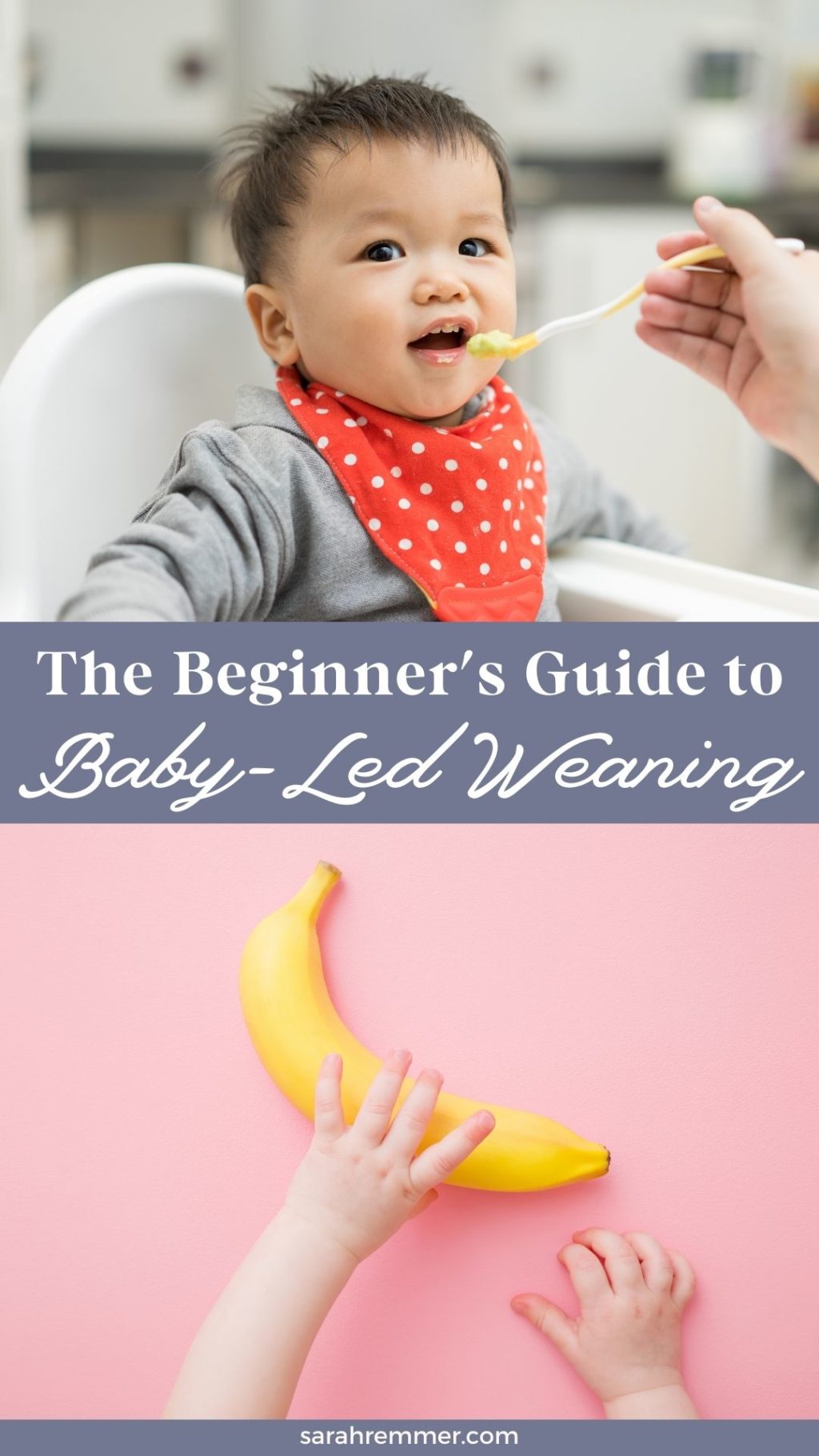
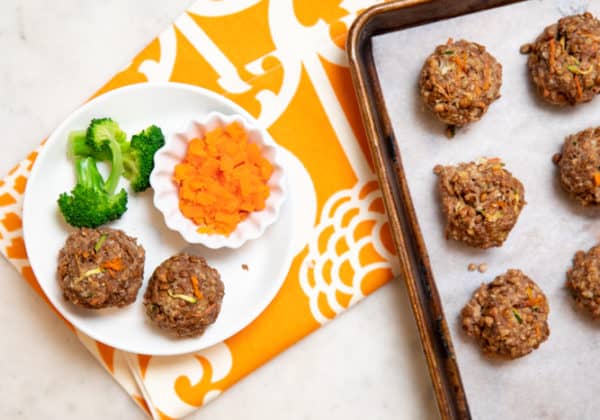
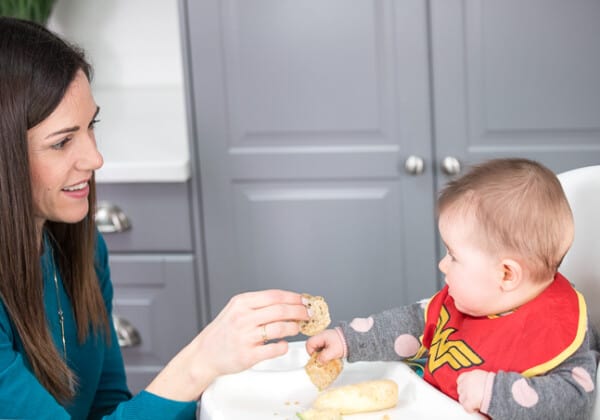
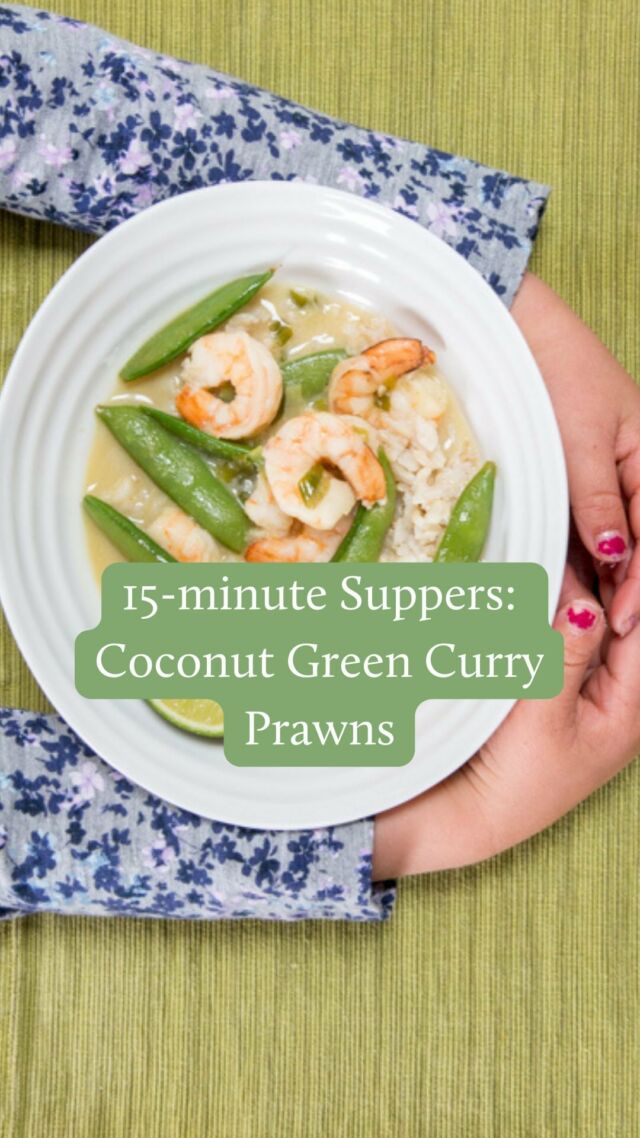
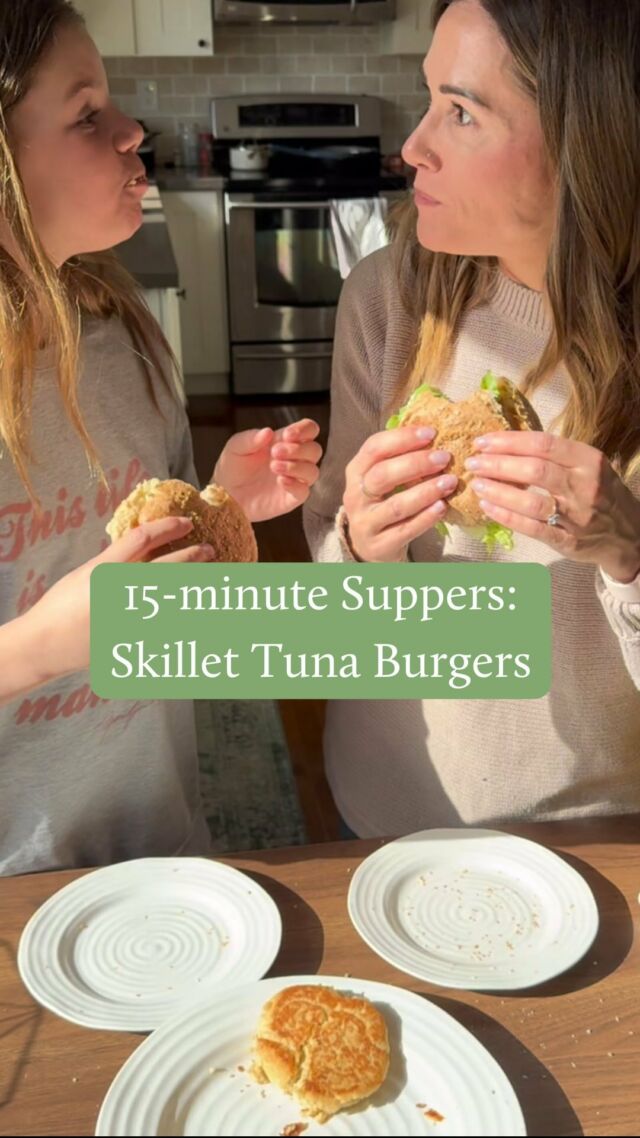
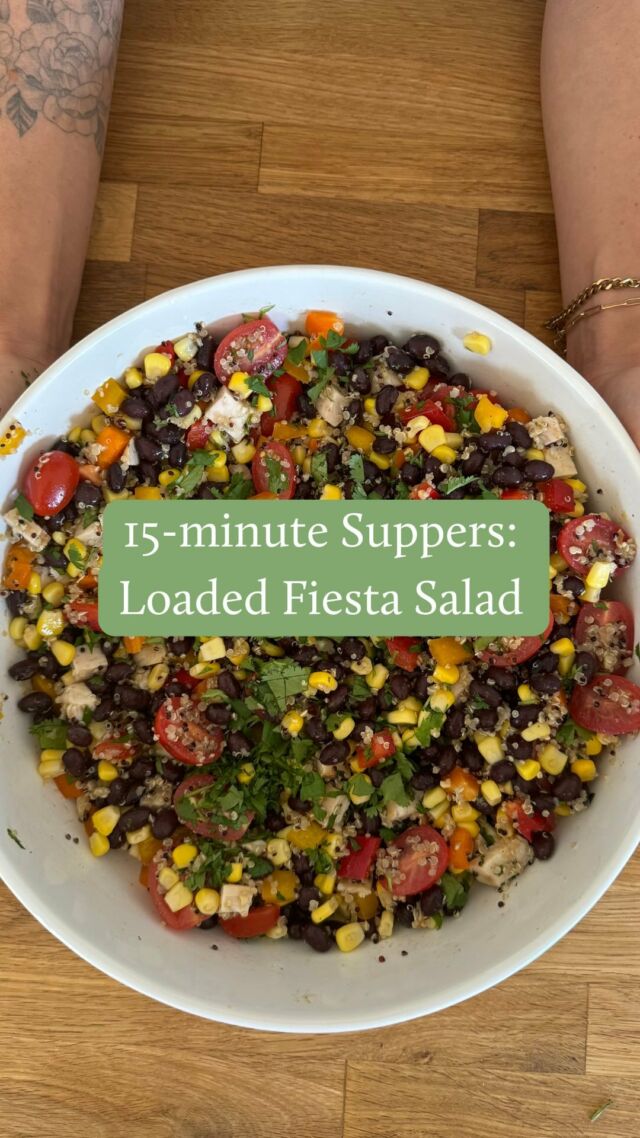

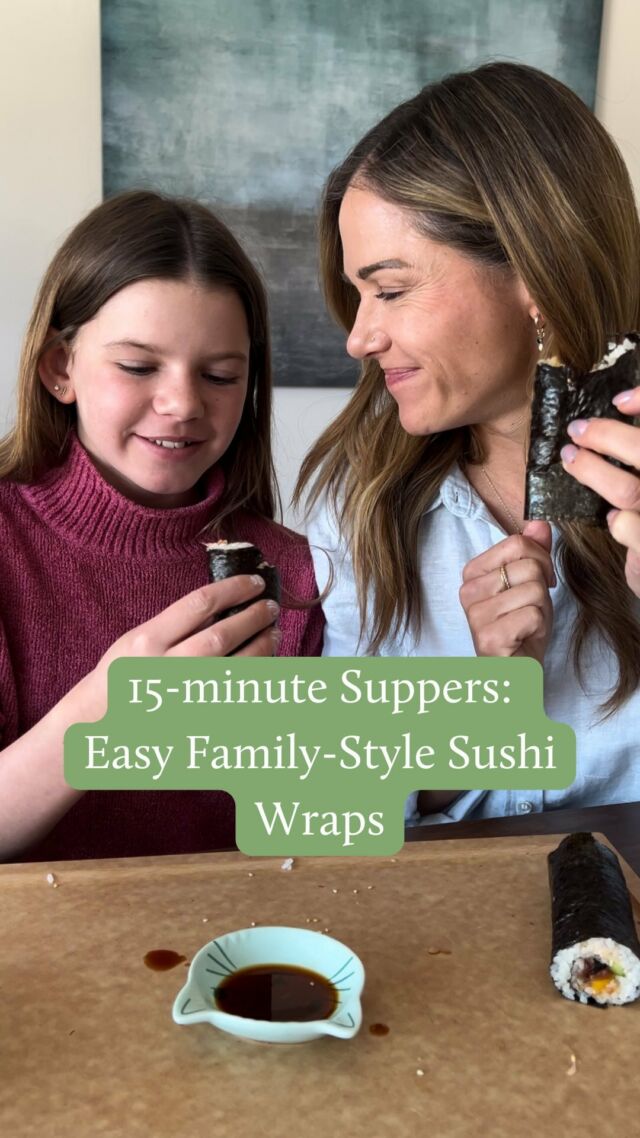
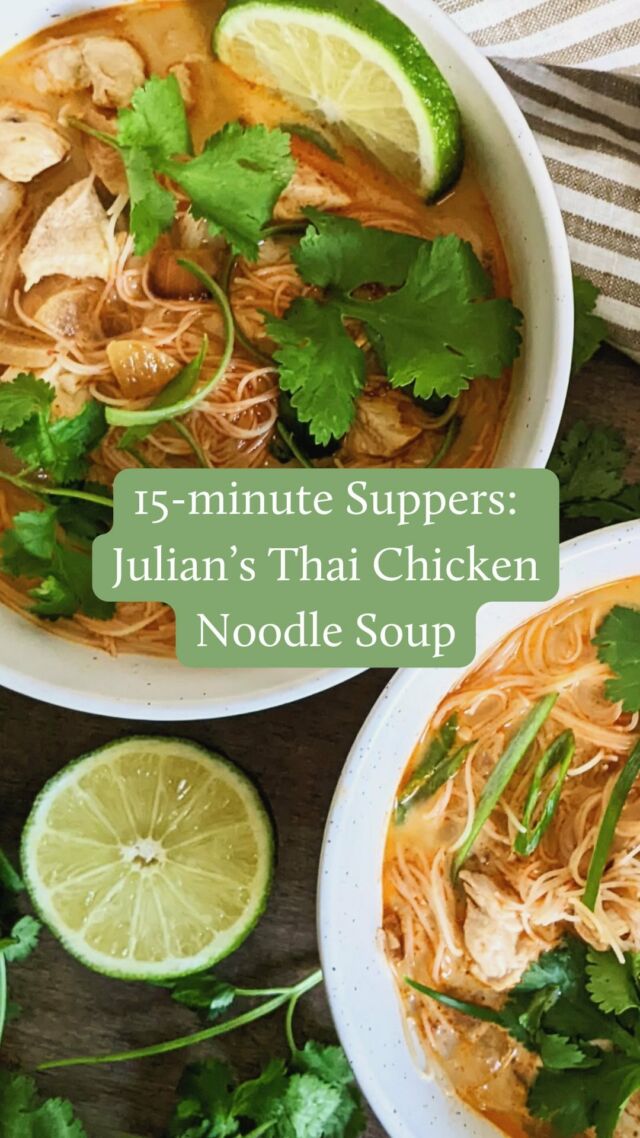
Comments
Niamul Islam Anan says
I like this healthy recipe a lot. Besides, it looks delicious.
Sarah Remmer says
Thank you so much, Niamul!
Linda says
Good article . The way how you explain this strategies. Is very professional.
Sarah Remmer says
Hi Linda! Thank you so much. That means a lot!
Margaret Peralta says
My little one loves to use forks and spoons but before the spoon even reaches his mouth it gets twisted. He can’t wait to use adult sized spoons even though we have bought him several cute little ones.
Heidi says
Hi Sarah,
This is very interesting information. You mentioned ‘there are many potential benefits to baby-led weaning, including improved dexterity, early oral-motor skill development, self-regulation, ease for parents, decreased picky eating and more’. Could you please share the research on this, specific to Baby Led Feeding/Weaning?
Thank you!
Sarah Remmer says
Hi Heidi. Sure thing! Benefits to BLW as it pertains to improved dexterity and oral-motor development are definitely linked to practice :). For self-regulation, ease for parents, and decreased picky eating this applies to the benefits and byproducts of the Division of Responsibility. The DOR encourages defined feeding roles of parents and children and results in decreased pressure from parents on children to consume food. By doing so children are less likely to exhibit picky eating characteristics and practice better self-regulation. That being said – the DOR can also be practiced in the spoon-feeding method as well!
For more information on BLW check out this article – https://link.springer.com/article/10.1007%2Fs13668-017-0201-2
For more information on the DOR check out this link – https://www.ellynsatterinstitute.org/how-to-feed/the-division-of-responsibility-in-feeding/
If you would like more information please feel free to send me an email at sarah@sarahremmer.com.
Hope this helps!
Keats Marley says
I was searching for such amazing article and I have ended up here. Thank you very much for sharing this kind of innovative post, I’m looking forward to grabbing more information on the same topic in the future!
Sarah Remmer says
Thanks so much!